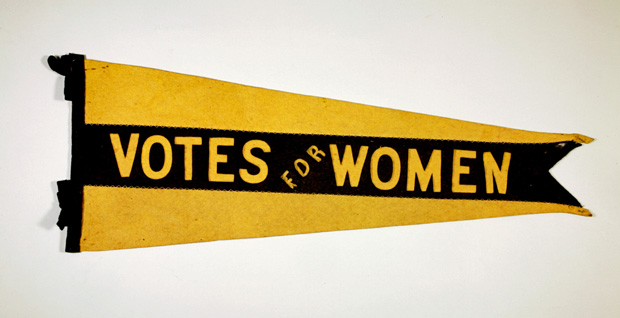On May 19, Mennonite Heritage Village (MHV) opened the newly arrived traveling exhibit Nice Women Don’t Want the Vote. Developed by the Manitoba Museum to celebrate the 100th anniversary of Manitoba women gaining the right to vote, this exhibit outlines the historical context of the Suffragist movement in Manitoba, identifies the women who had a direct influence in the movement, and acknowledges some of the movement’s shortcomings.
The exhibit title comes from a quote attributed to then-Manitoba Premier Sir Rodmand Roblin in a 1945 book by Nellie McClung: “‘Now you forget all this nonsense about women voting,’ [Roblin] went on in his suavest tones. ‘You’re a fine, smart young woman, I can see that. And take it from me, nice women don’t want the vote.'”
Despite Premier Roblin’s convictions, many women did want the vote. Calls for women’s suffrage began as soon as Canada became a country, but women did not get the right to vote federally until 1918. Women in Quebec were only allowed to vote provincially starting in 1940.
There were two prominent beliefs that underlaid women’s belief in their right to vote, though most women did not fully subscribe to one or the other and operated under a mixture of the two. The first was known as equal rights feminism, the belief that women had the inherent right to participate in society as equals to men. The second was maternal feminism, based on the premise that women were perceived to be more inherently moral than men. As such, their participation in the political process would lead to improvements in the lives of women and their children, eliminate social problems, and bring progress to society. Many suffragists also fought for reforms to property laws, which denied women title to their deceased husbands’ property, and for temperance, which called for the prohibition of alcohol.
Although the movement was incredibly important to the lives of women, Nice Women Don’t Want the Vote also touches upon some aspects that we find uncomfortable today. For example, enfranchisement (voting rights) was used as a means of assimilation. Women were only “worthy” of voting once they accepted the values of white, mainstream Anglo-Saxon Canadian society. For example, Mennonite men and women were denied the vote under Wartime Elections Act of 1917 due to their status as Conscientious Objectors. The suffragist movement also ignored the rights of Indigenous people. Until 1960, First Nations people, regardless of gender, were not allowed to vote unless they surrendered their status under the Indian Act.
Ideas about what it means to be a woman have changed drastically in the last century, thanks to succeeding “waves” of feminism, but we still have a ways to go. This makes one think. What other unwritten rules or assumptions do we use to exclude people or groups from participating fully in today’s society? What will people think about our culture in a hundred years?
After our visitors have gone through this exhibit, we invite each one to vote at our voting kiosk. The option is given to comment on three questions: “What is one issue facing Canadian women today that has yet to be resolved?”; “If you could say one thing to a suffragist from 100 years ago, what would it be?”; “I want to vote because…”
Nice Women Don’t Want the Vote may be viewed in the Gerhard Ens Gallery until June 19.
“Have we not the brains to think? Hands to work? Hearts to feel? And lives to live? Do we not bear our part in citizenship? Do we not help build the Empire? Give us our due!” ~ Nellie McClung




